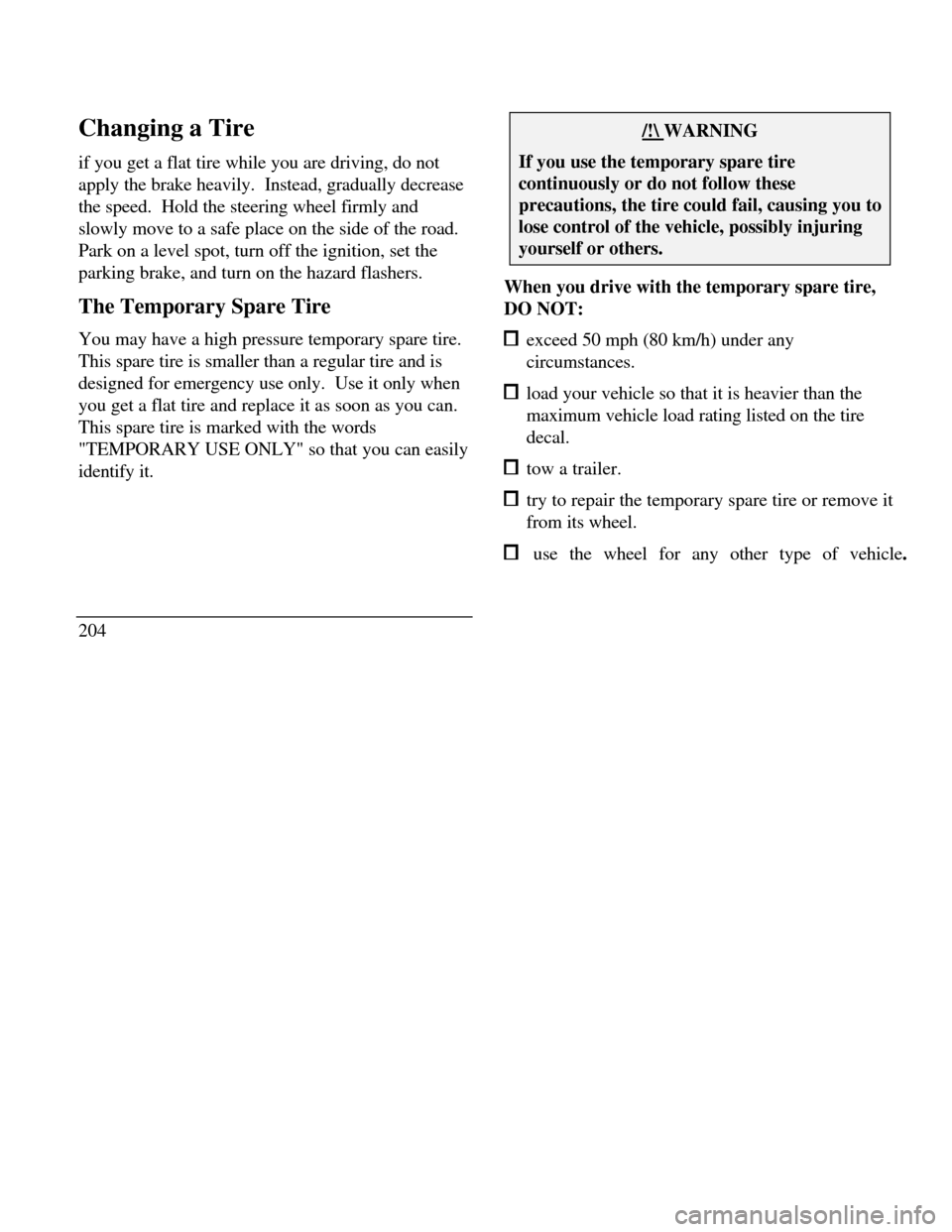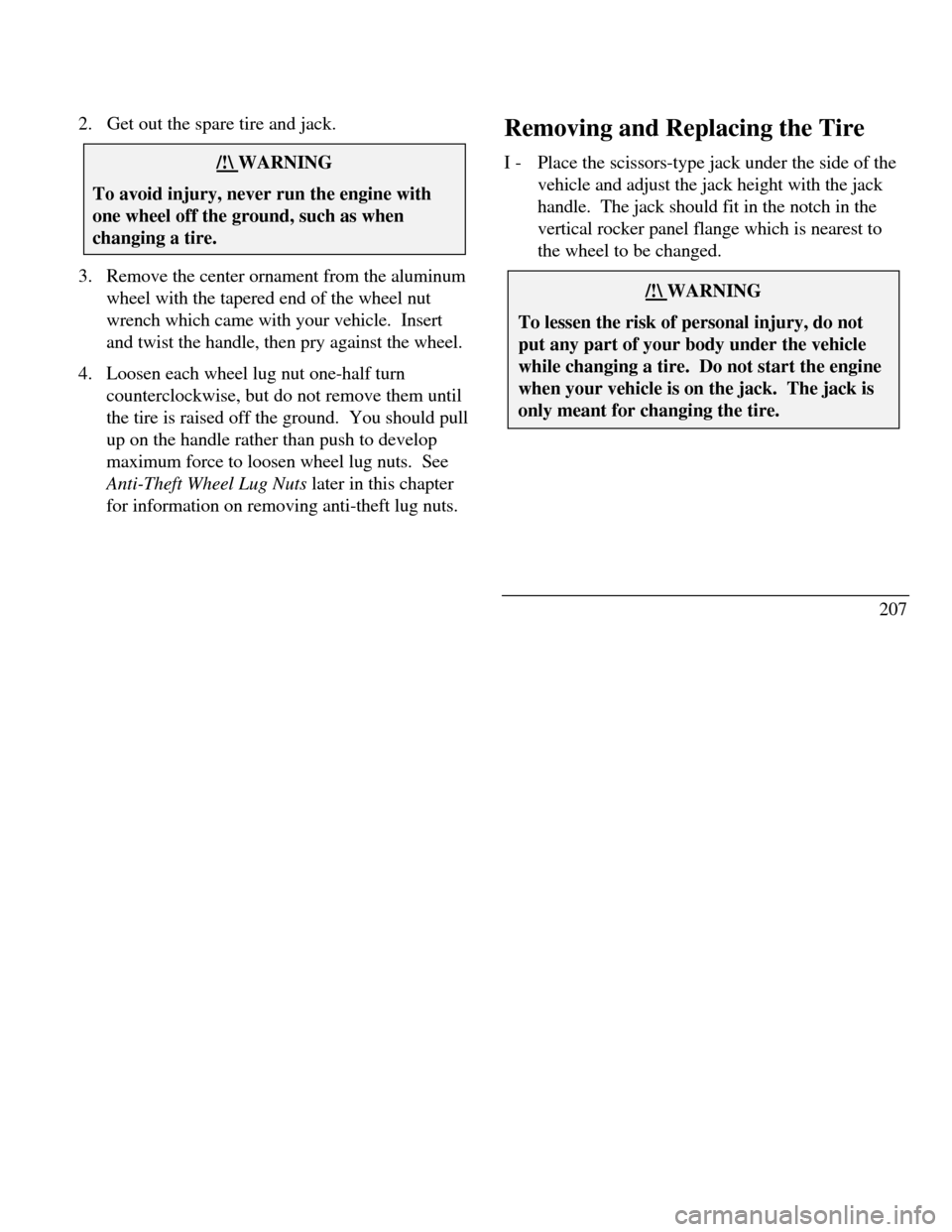Page 199 of 320

Towing ClassLight-dutyMaximum gross trailer
weight1,000/2,000 lbs. (454/907
kg)*Maximum tongue load100/200 lbs. (45/91 kg)Engine4.OLHitch designLoad carrying typeTraffer-tow package
optionNot requiredVehicle speed should not exceed 45 mph (72 km/h) when
towing on grades. Limit maximum gross trailer weight to
1,000 lbs. (454 kg) and maximum tongue load to 100 lbs. (45
kg): (1) when you are towing a trailer on steep hills or on
moderate hills for a long distance (five miles (8 kms) or more)
(2) on very hot days (when the temperature is 1OO°F (38°C)
or more).
You should also limit your trailer's load when you
tow in high altitudes.
196Preparing to Tow
For your safety and for the good of your
vehicle, use the right equipment for the type of
trailer you tow. Also, make sure that all
towing equipment is properly attached to your
vehicle. If you are not certain that you are
using the right equipment in the proper manner,
see your Ford or Lincoln-Mercury dealer.
Do not use hitches that clamp onto your
vehicle's bumper. The bumper is not designed
to bear the load.
Always check the pressure in all your vehicle's
tires when preparing to tow (see inflation
recommendation on the tire label).
Connecting the safety chains
Always attach the trailer's safety chains to your
vehicle. They help protect your trailer if the
hitch breaks.
Page 207 of 320

Changing a Tire
if you get a flat tire while you are driving, do not
apply the brake heavily. Instead, gradually decrease
the speed. Hold the steering wheel firmly and
slowly move to a safe place on the side of the road.
Park on a level spot, turn off the ignition, set the
parking brake, and turn on the hazard flashers.
The Temporary Spare Tire
You may have a high pressure temporary spare tire.
This spare tire is smaller than a regular tire and is
designed for emergency use only. Use it only when
you get a flat tire and replace it as soon as you can.
This spare tire is marked with the words
"TEMPORARY USE ONLY" so that you can easily
identify it.
204/! WARNINGIf you use the temporary spare tirecontinuously or do not follow theseprecautions, the tire could fail, causing you tolose control of the vehicle, possibly injuringyourself or others.When you drive with the temporary spare tire,
DO NOT: exceed 50 mph (80 km/h) under any
circumstances. load your vehicle so that it is heavier than the
maximum vehicle load rating listed on the tire
decal. tow a trailer. try to repair the temporary spare tire or remove it
from its wheel. use the wheel for any other type of vehicle.
Page 210 of 320

2. Get out the spare tire and jack./! WARNINGTo avoid injury, never run the engine withone wheel off the ground, such as whenchanging a tire.3. Remove the center ornament from the aluminum
wheel with the tapered end of the wheel nut
wrench which came with your vehicle. Insert
and twist the handle, then pry against the wheel.
4. Loosen each wheel lug nut one-half turn
counterclockwise, but do not remove them until
the tire is raised off the ground. You should pull
up on the handle rather than push to develop
maximum force to loosen wheel lug nuts. See
Anti-Theft Wheel Lug Nuts later in this chapter
for information on removing anti-theft lug nuts.Removing and Replacing the Tire
I -Place the scissors-type jack under the side of the
vehicle and adjust the jack height with the jack
handle. The jack should fit in the notch in the
vertical rocker panel flange which is nearest to
the wheel to be changed./! WARNINGTo lessen the risk of personal injury, do notput any part of your body under the vehiclewhile changing a tire. Do not start the enginewhen your vehicle is on the jack. The jack isonly meant for changing the tire.207
Page 250 of 320

Your vehicle's coolant protects your engine from
overheating in the summer and from freezing in the
winter. Check the level of the coolant at least once
a month. Simply look at the engine coolant
reservoir located in the engine compartment. To
locate the reservoir, see the diagram of your
vehicle's engine under Engine Type, in this chapter.
Check the engine coolant level in the engine coolant
reservoir at least once a month using the following
guidelines.
When your vehicle's engine is cool, the coolant level
in the engine coolant reservoir should be at the top
of the clear portion of the reservoir. If the level is
below the cold fill level, coolant may need to be
added.
The coolant additives also protect the entire cooling
system from internal passageway corrosion and
these additives lubricate the water pump. The
coolant should be serviced as noted in the
Maintenance Schedule and Record booklet.
248Adding engine coolant/!\ WARNINGDo not put engine coolant in the containerfor the windshield washer fluid.If sprayed to clean the glass, engine coolant or
antifreeze could make it difficult to see through the
windshield./!\ WARNINGNever remove the pressure cap while theengine is running or hot. Follow these stepsto avoid personal injury that can be causedby escaping steam or engine coolant.1. Before you remove the cap, turn the engine off
and let it cool. Even when the engine is cool, be
careful when you remove the pressure cap.
Page 260 of 320

/!\ WARNINGWhen replacing full size tires, never mixradial, bias-belted, or bias-type tires. Use onlythe tire sizes that are listed on the tirepressure decal. Make sure that all tires arethe same size, speed rating, and load-carryingcapacity. Use only the tire combinationsrecommended on the decal. If you do notfollow these precautions, your vehicle may notdrive properly and safely.Tires that are larger or smaller than your vehicle's
original tires may also affect the accuracy of your
speedometer.
258Information About Tire Quality Grades
New vehicles are fitted with tires that have their Tire
Quality Grade (described below) molded into the
tire's sidewall. These Tire Quality Grades are
determined by standards that the United States
Department of Transportation has set.
Tire Quality Grades apply to new pneumatic tires for
use on passenger cars. They do not apply to deep
tread, winter-type snow tires, space-saver or
temporary use spare tires, tires with nominal rim
diameters of 10 to 12 inches or limited production
tires as defined in Title 49 Code of Federal
Regulations Part 575.104(c)(2).
U.S. Department of Transportation - Tire quality
grades: The U.S. Department of Transportation
requires Ford to give you the following information
about tire grades exactly as the government has
written it.